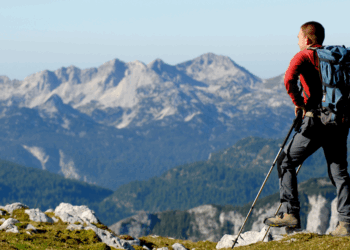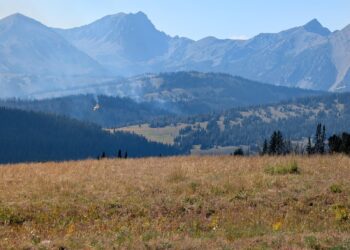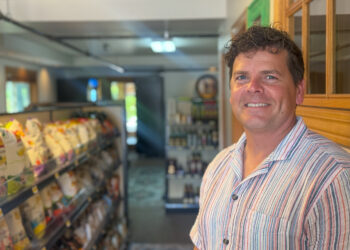By Mel Crichton EBS COLUMNIST

Maybe it’s March Madness, maybe few worry about wildfire with snow on the ground. But for a few dozen Big Sky residents, March 29 was their opportunity to learn how wildfire affects them and what they can do about it.
During an educational event at the Warren Miller Performing Arts Center, they heard from forester Jeff Cadry, local fireman Matty Kendziorski who served at the L.A. fires, Liz Davy, head of the Greater Yellowstone Fire Action Network, the Big Sky Fire Department’s new Division Chief of Wildland Fire Jon Trapp, and me, a volunteer with Fire Adapted Big Sky. The moderator for a panel discussion was Joseph T. O’Connor, managing editor of Mountain Journal. Three wildfire mitigation contractors showcased their services in the lobby.
Trapp explained that Big Sky is in the wildland-urban interface where settlement meets the forest; a forest full of flammables that should have burned years ago. But there are homes in the WUI, and a wildfire now would be disastrous. Of all the communities in the U.S., Big Sky is in the 96th percentile for wildfire risk. So it’s a matter of when, not if, we have a wildfire. Worried yet?
Panelists discussed that there’s a strong likelihood of a major wildfire in Big Sky, yet many here are complacent, confident that it won’t happen soon. Sorry, folks, but recent events show that wildfires can happen any time and almost anywhere. The time to defend against wildfire is now, before fire season.
Wildfires may start with lightning strikes, but most major wildfires start with human activity at lower elevations, where they burn faster and wider. With a warming climate, forest fuels dry out quicker, and wildfires are getting bigger and more frequent.


Canopy fires spread from treetop to treetop in dense forest, I explained. A fire can travel on the ground until it can reach into the canopy and ignite the trees. But canopy fires and ground fires destroy homes just a small part of the time. Up to 90% of homes that burn during a wildland fire are ignited by embers (firebrands) blown far ahead of the fire, perhaps a mile or more. Even a home in Big Sky’s Meadow Village won’t be safe.
Basics of proactive site mitigation
Trapp explained that home fires can be mitigated, meaning the homeowner can take measures to deny the embers a place to settle and ignite.
The most significant measures include Class A roofing that won’t ignite, denying ember access into the home with fine metal vent screening, and maintaining a “no fire zone” with no flammables within 5 feet of the home and deck. In Big Sky, some residents keep firewood stacked under the deck or on the porch all summer. If embers lodge there, kiss the firewood—and the home—goodbye. During a wildfire, the firefighters may have to give up on a risky home like this and save another that is fire hardened and more likely to survive the blaze.
Other measures to delay or stop wildfire include separating vegetation and trees around the home into small clusters, removing flammable vegetation and landscaping with plants and trees that are more fire resistant, and “limbing” trees so a ground fire can’t reach the lower branches. When trees are thinned, Cadry explained, it’s important to leave a variety of species in case a future kill wipes out one particular species.

Some mitigation work can be do-it-yourself, some may require a bonded mitigation contractor—don’t wait, because they could be overbooked and unavailable as fire season approaches.
Fire Adapted Big Sky and Alpenscapes are working together to get Big Sky ready. FABS has 16 volunteer neighborhood ambassadors versed in fire hardening and evacuation who work with neighbors to increase the odds of home and family survival—seven more signed up at the March 29 event. A benefit of home hardening could be increased insurability for the home, especially if the Montana legislature passes house bills 136 and 533 allowing premium discounts for hardening and requiring insurers to provide wildfire risk ratings to homeowners.
Homeowners should first get a fire department wildfire risk assessment before booking a contractor. The Big Sky Fire Department does it for free, but once summer comes, it may be too late to get on their schedule. Please act now.
On the Fire Adapted Big Sky Wildfire Hub are information links and the Big Sky Wildfire Action Guide that covers the basics of home hardening and evacuation preparation.
Before wildfire season arrives, we’ll have an interactive online site where residents can ask questions about wildfire. On June 23, we’ll hold another community forum on wildfire evacuation and dealing with smoke.
It’s our goal to minimize fire loss, but our bigger goal is to assure that everybody survives a Big Sky wildfire.
Mel Crichton acts as neighborhood ambassador coordinator for Fire Adapted Big Sky. He may be reached at kj9c@comcast.net.
The presentation on site mitigation can be found at https://bit.ly/4ljHGQh.














